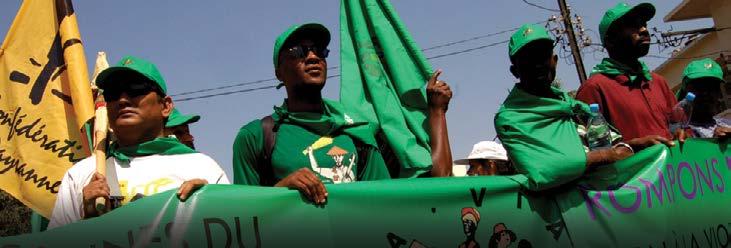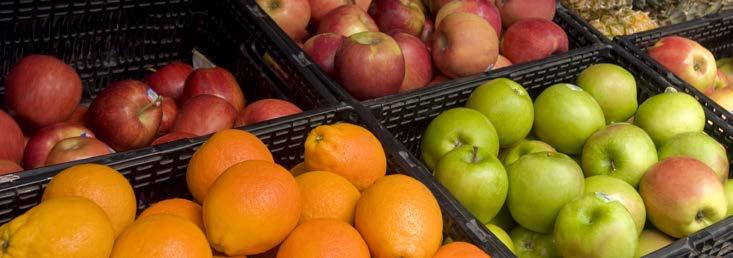
5 minute read
Radio CATA
by Meghan Hurley A Radio Station to Empower the Latino Community I n November of 2015, CATA, The Farmworkers Support Committee, officially launched Radio CATA, its own Spanishlanguage non-commercial low-power FM radio station in Bridgeton, New Jersey. The radio station began as a way to reach out to the immigrant community and engage them in CATA’s mission of organizing to fight for the rights they deserve. CATA members see the radio station as a crucial communication tool to build unity among Latinos as they struggle for justice in their workplaces and communities. Radio CATA
CATA members worked hard for more than a year, planning and fundraising to get the station up and running this past November. They participated in all aspects of the station construction, from soldering the cables to climbing the roof to install the antenna. The station plays on 102.5 FM in Bridgeton and is streaming online for the rest of the world to hear at www.radiocata.com. Through the radio station, CATA provides news reports and information on issues concerning the migrant community— immigration, workers’ rights, food justice—as well as local community announcements of CATA’s meetings, trainings, workshops, and other activities. A space has been created to talk about ques tions and concerns that members have in their workplaces and communities. There is also music, live programming, a weekly hour-long program on current events and situations facing the community. Since its first broadcast, Radio CATA has grown into a place of entertainment, education, and empowerment for its listeners. CATA Mission: CATA, The Farmworker Support Committee, is a non-profit, member-based organization governed by and comprised of farmworkers and migrant workers who are actively engaged in the struggle for better working and living conditions. CATA’s mission is to empower and educate its members through leadership development and capacity building. Projects and campaigns are undertaken with the goal of achieving meaningful and lasting improvements, rather than mere reforms to a legal and economic system that is structurally biased against them. CATA currently works with the Latino migrant community in New Jersey, Pennsylvania, Delaware, and Maryland.
Advertisement
Gene Alexander, USDA Natural Resources Conservation Service, Public Domain

1. Every five years, Congress passes legislation covering conservation programs, farm subsidies, the Supplemental Nutrition Assistance Program (SNAP), and virtually all other domestic food and agriculture policies. What is the common name of this legislation?
A. TPP B. Farm Bill C. Food Stamp Adjustment Act D. Farmer and Consumer Joint Bill of Rights
Wapcaplet, Creative Commons License

2. Which state was the first to pass legislation to phase in a $15/hour minimum wage for all, including restaurant workers and farmworkers?
A. New York B. Washington C. Oregon D. California
Shuhrataxmedov, Creative Commons license

4. The Cotton Campaign is a coalition of human rights, labor, investor, and business organizations. What is its goal?
A. Increase the price and market for cotton by educating consumers on the benefits of cotton over synthetic fibers. B. Get dirty cotton money out of politics. C. End the state systems of forced labor in Uzbekistan and Turkmenistan’s cotton sector. D. All of the above.
Fondo Andaluz de Municipios para la Solidaridad Internacional FAMSI via Flickr, Creative Commons License

5. What is food sovereignty?
A. The idea that the people who produce, distribute, and eat food should control their own food production, distribution, and governing policies. B. The idea that food really does rule the world. C. A certification that competes with fair trade and organic in the market to capture ethical consumers. D. A loose affiliation of independent natural products stores.
CDC, public domain

3. What has NAFTA’s impact been on fruit imports to the U.S. from Mexico, where labor is cheaper and farmworkers are paid as low as $10/DAY?
A. Fruit imports have been increasing by about 20% each year as companies move production across the border where they can pay farmworkers less money. B. Although at first the U.S. imported more fruits and vegetables from Mexico, thanks to the rise of CSAs, the U.S. now imports less produce than before NAFTA. C. Imports of fruits that can’t be grown in the U.S. have increased tenfold, but domestic farmers maintain their competitive advantage for produce they are able to grow—a win/win for consumers who now have better access to both local and exotic produce. D. The U.S. imports approximately the same amount of fruit from Mexico as before NAFTA, but it is less expensive, granting low-income families better access to healthy food.
AFGE, under Creative Commons license

6. What is one concern of activists opposed to free trade agreements such as the Trans-Pacific Partnership (TPP)?
A. These agreements will drive a “race to the bottom” by encouraging large multinational corporations to shift manufacturing jobs to countries that pay the lowest wages and have the lowest labor rights protections. B. The activists who oppose these agreements are fervent participants of the local food movement who would rather learn to grow coffee in greenhouses in the United States than trade with another country. C. Opponents of “free trade” believe that they will be required to give away goods for “free.” D. Opponents have questioned whether we should focus on universal drone delivery of consumer goods rather than rules for outdated modes of trade
Charles O’Rear, Public Domain

7. According to the International Labour Organization (ILO), which workers are most likely to be killed, injured, or get sick from their jobs?
A. Healthcare, garbage collection, and mining workers B. Construction, mining, and agriculture workers C. Agriculture, factory, and administrative office workers D. Professional drivers, construction workers, and teachers.
Rufino Uribe, uncder Creative Commons license

8. Which of the following ingredients might you expect to find certified as fair trade?
A. Coconut (oil or water) B. Cotton C. Sugar D. All of the above
Take A Picture With This Issue & Tag #FightForFair.
Whether it’s organizing for fair wages, building a sustainable food system, or combatting climate change, take our publication with you wherever you’re making change. Together we can build a more just world!
fairworldproject
fairworldprj
fairworldprj







